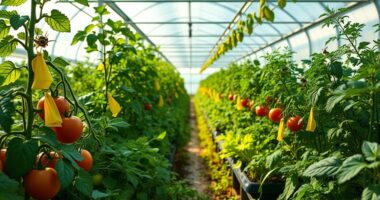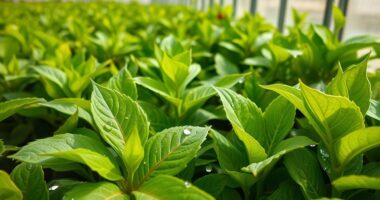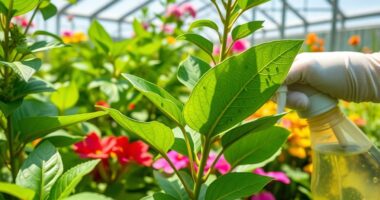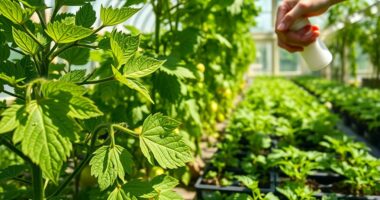Common pests in greenhouses, like aphids, whiteflies, and spider mites, can damage your plants. To control them, first monitor for signs of infestation, using yellow sticky traps to catch flying pests. Implement physical methods like fine-mesh screens and insect netting. You can introduce biological controls such as ladybugs or apply chemical options like pyrethrins for tough situations. Understanding these strategies will help keep your greenhouse healthy and thriving. There's even more you can do for effective management.
Key Takeaways
- Common greenhouse pests include aphids, whiteflies, fungus gnats, spider mites, and thrips, each causing distinct damage to plants.
- Monitor pest populations using yellow sticky traps and by identifying symptoms like discoloration and stunted growth.
- Implement physical controls such as fine-mesh screens, insect netting, and manual removal techniques to reduce pest presence.
- Utilize biological control strategies by introducing beneficial insects like ladybugs, lacewings, and parasitic wasps to manage pest populations.
- Consider chemical options like pyrethrins and horticultural oils, ensuring timely application and rotation to prevent resistance.
Overview of Common Greenhouse Pests

When you manage a greenhouse, understanding the common pests that can invade your plants is essential for maintaining a healthy environment.
Aphids, small and soft-bodied, reproduce rapidly and can spread harmful viruses.
Whiteflies also pose a threat as they suck sap from plants, leading to stunted growth.
Fungus gnats, often found in wet areas, can carry soil-borne diseases.
Spider mites, tiny and web-spinning, cause stippling and chlorosis on leaves.
Finally, thrips are tricky to control and can inflict significant damage while spreading diseases.
Recognizing these pests early on enables you to implement effective control strategies and protect your crops from potential harm.
Identification and Monitoring Techniques

Identifying and monitoring pests in your greenhouse is essential for effective crop management. Start by examining morphological features like mouthparts and wings to pinpoint specific insects.
Look for pest symptoms such as feeding damage, discoloration, and stunted growth. Understanding the life cycles of pests will enhance your management strategies.
Regularly inspect plants and use yellow sticky traps to catch flying pests like aphids. Consider incorporating indicator plants to gauge pest populations.
Scouting in a consistent pattern guarantees thorough coverage, and daily trap checks keep you informed on population changes.
For advanced techniques, explore automatic pest identification systems and deep learning models for real-time monitoring, allowing for proactive rather than reactive pest management.
Physical Control Methods for Pests

To effectively manage pests in your greenhouse, utilizing physical control methods is essential.
Start by installing fine-mesh screens on vents and doors to keep unwanted insects out while allowing airflow. Use insect netting to cover plants, protecting them from pests like aphids. For added protection, consider floating row covers, but remember to accommodate pollinators.
Incorporate traps like sticky or pheromone traps to monitor and control pest populations. Manual removal techniques, such as hand-picking or high-pressure water sprays, can also be effective.
Additionally, modify your environment with plastic mulch and manage temperature and humidity to deter pests. Regular inspections and proper cleaning practices will further enhance your pest control strategy, ensuring a healthy greenhouse.
Biological Control Strategies

While managing pests in a greenhouse can be challenging, biological control strategies offer an effective and environmentally friendly solution. You can use predatory insects like ladybugs and lacewings to combat pest populations.
Parasitic wasps such as *Aphidius colemani* target aphids, while predatory mites like *Phytoseiulus persimilis* help control spider mites. Beneficial nematodes can tackle larvae like fungus gnats.
Implementing these agents involves protecting natural enemies, introducing non-native species, or releasing large numbers periodically for immediate control. Make sure you maintain ideal temperature and humidity levels to support these beneficial organisms while minimizing pesticide use.
Chemical Control Options

When it comes to managing pests in your greenhouse, chemical control options provide an essential tool in your pest management arsenal.
Pyrethrins, derived from chrysanthemum flowers, disrupt insect nerve impulses, effectively eliminating pests. Horticultural oils and insecticidal soaps are safe alternatives that help target common nuisances like aphids and spider mites.
Pyrethrins and safe alternatives like horticultural oils effectively target pests such as aphids and spider mites.
Timely application during sensitive life stages maximizes effectiveness, while localized spraying minimizes environmental impact. Always control dosage to prevent resistance and rotate chemicals to keep pests at bay.
Guarantee compliance with local regulations and prioritize worker safety when applying these products. Integrating chemical controls within an Integrated Pest Management (IPM) approach enhances your overall pest management strategy.
Monitor pest populations regularly for best timing in chemical applications.
Preventive Measures for Pest Management

Chemical control options play a significant role in managing pests, but preventive measures are equally important for maintaining a healthy greenhouse environment.
Start by installing insect screens over windows and vents to keep pests out. Seal any gaps in your greenhouse structure to minimize entry points. Maintain ideal temperature and humidity levels, as well as proper ventilation, to discourage pest proliferation.
Regularly clean and sanitize your greenhouse to remove debris and potential pest habitats. Introduce beneficial insects like ladybugs and practice companion planting to repel unwanted pests.
Monitor your plants frequently for early signs of infestation, using sticky traps when necessary. By implementing these preventive measures, you'll create a thriving greenhouse that's less susceptible to pest issues.
Frequently Asked Questions
How Do Pests Affect Greenhouse Crop Yields?
Pests can severely impact your greenhouse crop yields by damaging plants and hindering their growth.
When pests infest your crops, they feed on essential plant sap, causing stunted growth and reduced photosynthesis. This stress weakens your plants, making them more susceptible to disease and further infestations.
As a result, you might notice lower yields and diminished quality, ultimately affecting your harvest and profits. Effective management is imperative to protect your crops.
Can Pests Survive Winter in Greenhouses?
Yes, pests can survive winter in greenhouses. You might find aphids and whiteflies overwintering, with their eggs remaining resilient in cold temperatures.
Thrips can endure mild winters, while spider mites enter a dormant state.
It's essential to be proactive in preventing their survival by maintaining cleanliness and controlling greenhouse conditions.
Regular monitoring and implementing effective pest management strategies will help you minimize their impact as spring approaches and temperatures rise.
What Are the Signs of a Severe Infestation?
When you notice signs of a severe infestation, look for visible damage like curled or yellowed leaves, or even large holes.
You might see high numbers of pests on your plants or in the air. Your plants could show significant decline, wilting, or even death.
Additionally, environmental factors like high humidity or temperature extremes can worsen the situation, making your plants more vulnerable to these pests and their harmful effects.
How Long Does It Take to Eliminate Pests?
It usually takes a few days to several weeks to eliminate pests, depending on the type and severity of the infestation.
You'll need to monitor the situation closely and apply control methods consistently.
Some biological treatments work quickly, while chemical solutions might require repeated applications.
Stay vigilant and adjust your approach as needed, ensuring you tackle both the pests and their potential habitats for best results.
Are There Organic Certifications for Pest Control Methods?
Getting organic certifications for pest control methods is like maneuvering through a maze; you need to know the rules.
Yes, there are certifications, like those from the National Organic Program (NOP), which require you to use approved materials and practices.
You'll need to maintain detailed records of your pest management strategies and guarantee that any synthetic pesticides you use have prior approval.
Staying compliant helps you maintain your organic status and grow healthy plants.
Conclusion
In the battle against greenhouse pests, staying proactive is your best weapon. By combining identification, physical, biological, and chemical control methods, you can safeguard your plants and guarantee a thriving environment. Remember, it's not just about fighting pests when they appear; it's about creating a fortress that keeps them at bay. So, don't wait for the invasion—act now and cultivate a healthier greenhouse for your plants to flourish! After all, prevention is better than cure.









